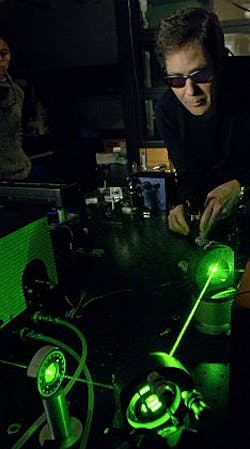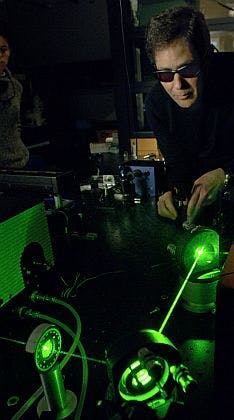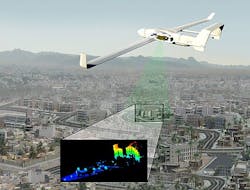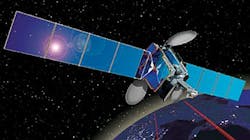Communicating at the speed of light: laser technology enables high-bandwidth communication and imagery
SPECIAL REPORT, 6 June 2012. When a mortar shell is falling from the sky, warfighters need precise sensors that work at the speed of light; when warfighters need to remove a mortar from the sky, they need communications that work at the speed of light. Until it’s been proven otherwise, light speed is still the fastest anything can travel, and that’s why laser communications and laser sensing are so important in mortar defense and other crucial aerospace and defense applications.
Since the advent of lasers in the military more than 30 years ago for tracking targets and guiding weapons, lasers have been a growing part of many military systems. As the military picks up fiber optics, and as newer and smaller sensors are released continually, electro-optics are going to the field more frequently than ever. From sensors, to optical fiber, and satellite communications, lasers are everywhere not just in military systems, but in avionics as well.
Modern lasers represent a massive improvement over lasers of the past, and the technology is advancing just as quickly now as it has been for the past decade. Optical fiber has demonstrated the ability to move hundreds of terabits of information per second. In addition, lasers are able to see through dense foliage, and can allow for space communication from distances measured in millions of miles. The capabilities of modern lasers almost are like science-fiction stories, and the technology involved is still improving.
Lasers for sensing
Common uses for lasers in sensing include determining precise location information that radar and traditional sighting systems for kinetic weapons like rifles and missiles cannot provide. "When using lasers with a weapon system they're a complement to kinetic systems,” explains Michael Rinn, vice president of the Boeing Co. Directed Energy Systems segment in Albuquerque, N.M.
Lasers "offer an advantage of cost-per-shot, precision ranging, and precision pointing," Rinn continues. "From three, four, or five kilometers away a laser can focus on a moving target precisely. Radar and gun systems are nowhere near the kinds of ranges we're demonstrating." Of course, lasers aren’t a replacement for any system, but they serve to compliment systems by providing additional information.
Light detection and ranging (LIDAR) is one of the primary ways lasers can sense objects and movement. LIDAR can create images by bouncing lasers off a target. Narrow-beam lasers enable LIDAR to detect images where other sensors could not, such as finding objects in heavy foliage or finding exact distances, heights, chemical compounds, and atmospheric composition. LIDAR not only provides this information, but also can render still images in three dimensions. Given sufficient processing power, lasers also can render moving images that look like videos.
Scientists have used LIDAR to guide unmanned aerial vehicles (UAVs), including an AH-6 unmanned Little Bird light helicopter gunship, through areas with obstacles. LIDAR provides the precision necessary for autonomous piloting, a hot commodity at a time when UAVs require at least one operator. The AH-6 is a military version of the MD 500 light helicopter.
As with any advancing technology -- especially one that involves as much computation as laser technology does -- the size of laser systems has shrunk to sizes that were unimaginable when they were first introduced. “We're seeing leaps and bounds in the technology," says Boeing’s Rinn. "Sizes have gone down from racks to credit-card size; you're seeing a lot of transformation in the industry.”
Early-model laser systems were big, awkward, and used too much power to make them practical for vehicles. Today's lasers, however, can fit in small boxes and can be parts of UAV payloads, fixed-site perimeter-security systems, helicopters, and ground vehicles.
Laser limitations
Laser sensing does have a weakness, when compared to other kinds of sensors. “Heavy rain, really bad weather conditions, and sandstorms, cause problems for lasers,” explains Boeing’s Rinn. Adverse weather conditions prevent laser light from reaching its target. Even heat waves can distort the laser beam and lead to inaccurate or lost data. Fortunately, there is a way around atmospheric issues with lasers.
“A normal beam uncorrected will start to disperse and spread," explains Boeing’s Rinn. "If I can correct for that atmosphere real-time I get more energy on the target."
The answer to this problem is an atmospheric-compensation sensor that uses a low-power beam before correcting itself. The now-discontinued Airborne Laser (ABL) program, for example, sent out a low-power laser before firing its powerful chemical laser. The low-power laser measured atmospheric distortion between the aircraft and its target, and used that information to calibrate the laser weapon to put the most energy possible on target.
Atmospheric compensation enables the use of lasers even in harsh environments that would render uncorrected laser sensors useless. Atmospheric compensation does not allow lasers to function in particularly bad conditions, however. Atmospheric distortion happens when air currents or pollution bends light, and is the phenomenon that makes the stars at night appear to twinkle.
Lasers for communications
Fiber-optic cable has seen huge improvements in the past decade. With potential data rates that reach data rates of terabits per second, lasers can move vast quantities of data more securely than other forms of communications.
Fiber optics technology has one development called wavelength-division multiplexing (WDM) that increase data rates by leaps and bounds. WDM involves placing many optical carrier signals onto one optical fiber by using different wavelengths of laser light. While the concept of WDM is not a new one -- the technique first was used in 1978 -- modern systems use more than 160 signals in one optical fiber.
Lasers also have been used in communications without optical fiber. “Laser communication is a very specific application -- satellite-to-satellite, terrestrial-to-satellite, terrestrial-to-airplane -- are very high bandwidth applications that lasers can do.” Boeing’s Rinn says. Lasers can be used for communication without any cables to communicate from huge distances, particularly in space.
This practice, called free-space optical communications, uses laser beams that travel through the air, or through outer space, instead through optical fiber, and is generating substantial industry excitement for its potential in broadband data communications.
The NASA Jet Propulsion Laboratory (JPL) in Pasadena, Calif., in fact, has created its own free-space optical communications research group. More information on the NASA group is online at http://lasers.jpl.nasa.gov.
Free-space optical communications send lasers operating at wavelengths not visible to the human eye to receivers for high-bandwidth line-of-sight communications. The benefit of free-space optical communication over radio signals is clear. Free-space optical communication does not experience interference from radio waves and is nearly impossible for an enemy to intercept or disrupt.
Inter-satellite communications links can send and receive data that are exponentially larger than RF signals can provide, while using less power. NASA’s own project, the Laser Communications Relay Demonstration, seeks to prove the long-term viability of free-space optical communication and increase current inter-satellite data rates by as much as a hundred times greater than current RF communication allows. The Laser Communications Relay Demonstration will be holding preliminary design review in 2013, with ground testing starting in 2014. The project will then fly as a commercial satellite payload in 2016.
Future laser technology
Laser technology has yet to mature, and many enhancements are left to be made. Everything lasers can do currently is still improving at a rapid rate and new techniques to improve lasers are still in the works. One such new technique is beam combining, which blends several laser streams into one high-power beam.
Each approach has its own uses, benefits, and downsides. The goal of beam combining is to increase laser power and brightness to enable long-distance communications and laser weapons.
Beam combining techniques
Beam combining seeks to scale-up laser power by combining the beams of several lasers while preserving beam quality and increasing brightness.
Coherent beam combining relies on mutual coherence of beams with very low relative phase deviations to create one powerful beam. The two methods of combining using this technique are side-by-side combining and filled-aperture combining. Side-by-side combining is a process in which four fiber amplifiers produce lasers that are combined into one beam with a larger area. Filled-aperture combining, meanwhile, combines several beams into one laser with the same beam size and divergence using a grating splitter. Both of these methods produce more power and brighter beams, but side-by-side combining also increases the size of the output beam.
Spectral beam combining uses multiple beams with non-overlapping optical spectra and combines them in a wavelength-sensitive beam combiner such as diffraction gratings or a prism. Still, spectral beam combining can have lower power scalability due to the amount of heat the beam combiner may absorb during the process. Spectral beam combining is suitable for fiber lasers, since fiber-based systems have higher-power emitters with larger-gain bandwidth, allowing for higher power lasers.
Polarization beam combining blends two linearly polarized laser beams -- one vertically polarized and the other horizontally polarized. These beams move to a thin-film polarizer so that one is reflected and the other transmitted, forcing both beams to propagate in the same direction. This creates an unpolarized beam with almost the same optical power as the two input beams combined, and with the same beam quality. Brightness similarly increases. Polarized beam combining does not scale power, however, because the unpolarized output cannot go through the same process.
“It is expected that beam-combined laser systems will in the near future reach output power levels of tens to hundreds of kilowatts,” Paschotta says. “Possible applications of such systems are in the military sector in the context of anti-missile and other directed energy laser weapons. There are also possibilities for long-distance free-space optical communication and laser-based manufacturing.”
Rapid improvement
Boeing’s Rinn explains why laser technology has been increasing at the pace it has. “We poured hundreds of millions of dollars into the telecomm industry in the mid '90s, and there was a huge advancement. Sensors are not only appearing in military systems, but they're starting to appear in everyday life.”
Factories use sensors to guarantee product quality. The advent of cell phones and constant communications with satellites has raised demands for better communications. The transoceanic fiber cables that sit at the bottom of the ocean, coupled with data demands that almost double yearly thanks to the explosion of streaming video has also led to more and more research being performed on optimizing optical communications and optics in general.
“There's a photonics revolution that's been going on for over a decade now,” Boeing’s Rinn says, “you're starting to see photonics in computing and telecommunications. As we get more efficient, faster processing you're going to see even higher bandwidths. We're using fiber now and there are plenty of examples of how bandwidth is increasing.”





